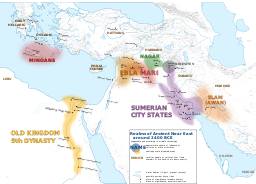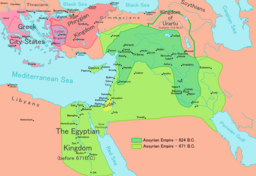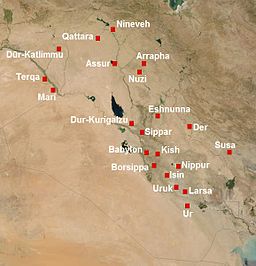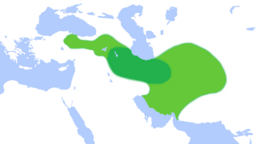
The Iraqi Republican Guard was a branch of the Iraqi military from 1969 to 2003, which existed primarily during the presidency of Saddam Hussein. It later became known as the Republican Guard Corps, and then the Republican Guard Forces Command (RGFC) with its expansion into two corps. The Republican Guard was disbanded in 2003 after the invasion of Iraq by a U.S.-led international coalition.

Karbala or Kerbala is a city in central Iraq, located about 100 km (62 mi) southwest of Baghdad, and a few miles east of Lake Milh, also known as Razzaza Lake. Karbala is the capital of Karbala Governorate, and has an estimated population of 603,000 people (2024).
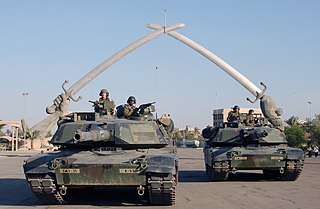
The following is a timeline of major events during the Iraq War, following the 2003 invasion of Iraq.
Events in the year 2004 in Iraq.

Ashura is a day of commemoration in Islam. It occurs annually on the tenth of Muharram, the first month of the Islamic calendar. For Sunni Muslims, Ashura marks the parting of the Red Sea by Moses and the salvation of the Israelites. Also on this day, Noah disembarked from the Ark, God forgave Adam, and Joseph was released from prison, among various other auspicious events on Ashura in Sunni tradition. Ashura is celebrated in Sunni Islam through supererogatory fasting and other acceptable expressions of joy. In some Sunni communities, the annual Ashura festivities include carnivals, bonfires, and special dishes, even though some Sunni scholars have criticized such practices.

The Mahdi Army was an Iraqi Shia militia created by Muqtada al-Sadr in June 2003 and disbanded in 2008.
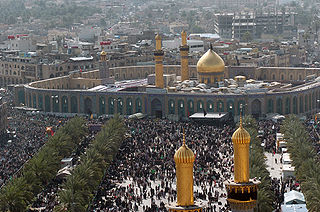
In Shia Islam, Arba'in marks forty days after Ashura, which is the death anniversary of Husayn ibn Ali, grandson of the Islamic prophet Muhammad and the third Shia imam. Husayn was killed, alongside most of his relatives and his small retinue, in the Battle of Karbala on 10 Muharram 61 AH against the army of the Umayyad caliph Yazid ibn Mu'awiya. The battle followed Husayn's refusal to pledge his allegiance to Yazid, who is often portrayed by Muslim historians as impious and immoral. In Shia Islam, Karbala symbolizes the eternal struggle between good and evil, the pinnacle of self-sacrifice, and the ultimate sabotage of Muhammad's prophetic mission.

The Imam Husayn Shrine is the mosque and burial site of Husayn ibn Ali, the third Imam of Shia Islam, in the city of Karbala, Iraq. It stands on the site of the Mausoleum of Husayn, who was a grandson of Muhammad, near the place where he embraced martyrdom during the Battle of Karbala in 680 CE The tomb of Husayn is one of the holiest sites in Shia Islam, outside of Mecca and Medina, and many make pilgrimages to the site. Every year, millions of pilgrims visit the city to observe Ashura, which marks the commemoration of Husayn's death for all Muslims.

The Second Battle of al-Faw (also known as the Operation Ramadan Mubarak (Blessed Ramadan), fought on 17 April 1988, was a major battle of the Iran–Iraq War. After their defeat at the First Battle of al-Faw two years earlier, the newly restructured Iraqi Army conducted a major operation to clear the Iranians out of the peninsula.

The 30th Infantry Regiment is a United States Army infantry regiment. It was originally constituted 2 February 1901 in the Regular Army as the 30th Infantry. It was organized 12 February – 19 August 1901 at Fort Logan, Colorado, at the Presidio of San Francisco, California, and in the Philippines.

The Battle of the Karbala Gap occurred during the 2003 invasion of Iraq. The Karbala Gap is a 20–25-mile wide strip of land with the Euphrates River to the east and Lake Razazah to the west. This strip of land was recognized by Iraqi commanders as a key approach to Baghdad, and was defended by the Medina and Bakhtnisar Divisions of the Iraqi Republican Guard. American forces attacked Iraqi forces in the area with massive air attacks followed by concentrated armored thrusts which resulted in the Iraqi units being surrounded and annihilated.

The Battle of Karbala took place during the 2003 invasion of Iraq as U.S. troops fought to take control of the city from Iraqi forces. The city had been bypassed during the advance on Baghdad, leaving American units to clear it in two days of street fighting against Iraqi Saddam Fedayeen Irregular forces.

The 2003 attack on Karbala was an unsuccessful strike on the Iraqi Republican Guard's Medina Division by the U.S. 3rd Infantry Division during the 2003 invasion of Iraq. The Medina Division was mostly deployed along the Karbala gap, west of the city of Karbala itself. The Iraqi Division was targeted as it was the best equipped Iraqi unit, and its destruction would negatively affect Iraqi military morale. The Medina Division sustained only limited damage during the engagement.

The siege of Basra, code-named Operation Karbala-5 or The Great Harvest, was an offensive operation carried out by Iran in an effort to capture the Iraqi port city of Basra in early 1987. This battle, known for its extensive casualties and ferocious conditions, was the biggest battle of the war and proved to be the last major Iranian offensive. The Iranians failed to reach their objective.

The Arba'in pilgrimage is the world's largest annual public gathering. It is a pilgrimage to the shrine of Husayn ibn Ali, grandson of the Islamic prophet Muhammad and the third Shia imam. Every year, on the twentieth of Safar, also known as Arba'in, millions of pilgrims flock to Karbala, Iraq, often arriving there on foot from the nearby city of Najaf. Arba'in marks forty days after the tenth of Muharram, known as Ashura. On this day in 61 AH, Husayn was killed, alongside most of his relatives and his small retinue, in the Battle of Karbala against the army of the Umayyad caliph Yazid ibn Mu'awiya. The battle followed Husayn's refusal to pledge his allegiance to Yazid, who is often portrayed by Muslim historians as impious and immoral. In Shia Islam, Karbala symbolizes the eternal struggle between good and evil, the pinnacle of self-sacrifice, and the ultimate sabotage of Muhammad's prophetic mission.
Operation Karbala-9 was an offensive operation in Iran–Iraq War, which was launched by Islamic Republic of Iran Army with the operation code of "Ya Mahdi, Adrekni" on 9 April 1987. This operation ended inconclusively, and Iran had very large casualties from the numerous Iraqi traps.






